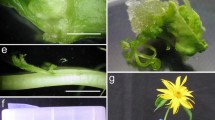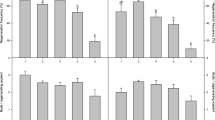Abstract
Cotyledonary mesophyll cells of Lycopersicon esculentummay be induced to form vessels with exogenously applied 2,4-dichlorophenoxyacetic acid and 6-benzylaminopurine. As a basis for determining the molecular events involved in the induction of competence for xylogenesis, we have determined that the entry of the exogenous plant bioregulators into the explant is through both the cut surfaces and intact epidermis; the mesophyll cells adjacent to the vascular system are the first to be induced to form vessels, appearing to be pre-programmed for the first phase of the genetic programme for vascular differentiation and so forming one set of channels of plant bioregulator flow for the determination of some of the subsequently transformed cells; and the remainder of the mesophyll cells are induced through the exogenously applied plant bioregulators entering through the surface of the cotyledon.
Similar content being viewed by others
References
Alizadeh S & Mantell SH (1991) Early cellular events during direct somatic embryogenesis in cotyledon explants of Solanum aviculare Forst. Ann. Bot. 647: 257–263
De Klerk GJ, Keppel M, Ter Brugge J & Meekes H (1995) Timing of the phases in adventitous root formation in apple microcuttings. J. Exp. Bot. 46: 965–972
De Klerk GJ, Van der Krieken W & De Jong J (1999) The formation of adventitious roots: new concepts, new possibilities. In Vitro Cell Dev. Biol. Plant 35: 189–199.
Delbarre A, Muller P, Imhoff V & Guern J (1996) Comparisons of mechanisms controlling uptake and accumulation of 2,4-dichlorophenoxyacetic acid, naphthalene-1-acetic acid and indole-3-acetic acid in suspension-cultured tobacco cells. Planta 198: 532–541
Gahan PB (1984) Plant Histochemistry and Cytochemistry: An Introduction. Academic Press, London
Gahan PB (1991) Quantitative enzyme cytochemistry in plant biotechnology. Phytochem. Anal. 2: 97–106
Gahan PB & Carmignac DF (1989) Determination of vascular tissue in roots of dicotyledonous plants. In: Loughman BC, Gasparikova O & Kolek J (eds) Structural and Functional Aspects of Transport in Roots (pp 25–28). Kluwer Academic Publishers, Dordrecht
Gahan PB & Wyndaele R (1996) R. Endogenous levels of plant bioregulators during the in vitro period for organogenesis. In: Physiology and Control of Plant Propagation in vitro (pp 4–10) COST 822 EU Programme, Berlin 9-13.10.96
Gahan PB, Rana MA & Phillips R (1983) Activation of carboxyl-esterase in root cortical parenchymal cells of Pisum sativum during xylem induction, in vitro. Cell Biochem. Function 1: 109–111.
Gahan PB, Pinto E, Court S, Eze K, Wang L & Mantell SH (1994) Plant growth regulator-induced xylogenesis in cotyledons of Solanum aviculare. J. Exp. Bot. 45: 1523–1532
Gahan PB, Wang L & Wyndaele R (1995) Possible mechanisms of plant bioregulator modulation of mesophyll cells to form vessels. Proc. 9th Forum of Appl. Biotech. Univ. of Gent. 1: 1539–1544
Gahan PB, Wang L, Bowen ID & Winters C (1998) Cytokinin-induced apoptotic-like changes in mesophyll cells of cotyledons. SEB meeting 14-17/12/98 Exeter. Programmed Cell Death in Health & Disease. Abstracts (p 19).
Guan H & De Klerk GJ (2000) Stem segments of apple microcuttings take up auxin predominantly via the cut surface and and not via the epidermal surface. Sci. Hortic. 86: 23–32.
Hyodo H (1991) Stress/Wound Ethylene. In: AK Mattoo & JC Suttle (eds) The Plant Hormone Ethylene (pp 43–63) CRC Press, London
Murashige T & Skoog F (1962) A revised medium for rapid growth and bioassays with tobacco tissue cultures. Physiol. Plant. 15: 473–479
Phillips R (1987) Effects of sequential exposure to auxin and cytokinin on xylogenesis in cultured explants of Jerusalem artichoke (Helianthus tuberosus L). Ann. Bot. 59: 245–250
Rana MA & Gahan PB (1983a) A quantitative cytochemical study of xylem element formation in response to wounding in roots of Pisum sativum. Planta 157: 307–316
Rana MA & Gahan PB (1983b) Determination of fascicular, interfascicular and cork cambia in dicotyledonous plants. Saussurea 14, 51–60.
Sachs T (1981) The control of patterned differentiation of vascular tissues. Adv. Bot. Res. 9: 151–262
Shininger TL (1980) Biochemical and cytologocal analysis of RNA synthesis in kinetin-treated pea root parenchyma. Plant Physiol. 65: 838–843
Author information
Authors and Affiliations
Rights and permissions
About this article
Cite this article
Wang, L., Wyndaele, R. & Gahan, P. Induction of vessels in cotyledons of Lycopersicon esculentum by exogenously applied plant bioregulators. Plant Cell, Tissue and Organ Culture 70, 213–221 (2002). https://doi.org/10.1023/A:1016308207438
Issue Date:
DOI: https://doi.org/10.1023/A:1016308207438




